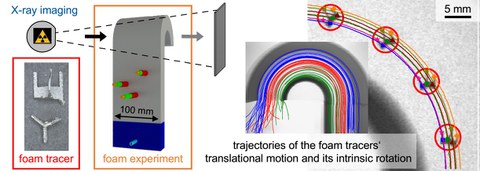X-ray particle tracking
X-ray-based imaging measurements of liquid foam flows
Person in charge: Dr.-Ing. Tobias Lappan
Project leader: Dr.-Ing. Sascha Heitkam
Duration: 05/2020 – 04/2026
Funding: DFG / Emmy-Noether
Project description
Optical observation is the only measurement technique commonly used for measuring liquid foam flows. Because liquid foams – in particular wet foams with relatively high liquid fraction – are opaque to visible light, optical measurements are limited to the foam’s free surface or the bubble-scale foam structure close to a transparent wall. Using X-ray light instead of visible light, we are able to gain direct insight into foam flow phenomena that are usually hidden below the surface-near bubble layers.
For this purpose, we used custom-tailored particles made by 3D-printing as foam flow tracer particles (Fig. 1). These tracers were able to attach to the bubble-scale foam structure, followed the foam flow sufficiently well, and were clearly visible in time-resolved X-ray image sequences. The tracers’ translational and rotational motions were analysed in order to reveal the velocity field of the foam flow as well as bubble rearrangements in the foam structure.
Unlike quasi-two-dimensional optical measurements, this approach of X-ray particle tracking velocimetry (X-PTV) is applicable to liquid foam flows in three-dimensional flow configurations. To demonstrate the applicability and to test various foam tracer particles, we measured liquid foam flows of different velocities and bubble sizes inside a curved flow channel, showing the expected rigid-body-like flow pattern in this configuration.
Fig. 1: Metallic tracer particles act as tools for imaging measurements in liquid foam flows. While the foam is transparent for X-rays, the tracers are visualised detailed in X-ray images. Tracking algorithms are applied to measure the tracers’ motions, thus revealing the streamlines of the foam flow.
Aiming to reduce measurement uncertainties in X-PTV measurements in foam and froth flows, we developed composite tracer particles with standardised shape, size and mass (Fig. 2). These particles were added to the overflowing foam in a laboratory-scale experiment inspired by a froth flotation cell. Focusing on the weir, which here describes the one-sided horizontal overflow, we measured the velocity profile in vertical direction above the weir crest and found that the maximum velocity is reached underneath the free surface of the overflowing foam.
Fig. 2: Tracer particles, made of small 3D-printed polymer tetrahedra with tiny metal beads glued to the tetrahedral tips, were used for X-ray particle tracking velocimetry, investigating the overflowing foam in a laboratory-scale experiment similar to froth flotation.
Publications
-
T. Lappan, D. Herting, M. Ziauddin, J. Stenzel, N. Shevchenko, S. Eckert, K. Eckert, and S. Heitkam: X-ray Particle Tracking Velocimetry in an Overflowing Foam. Applied Sciences, 13(3), 1765, DOI: https://doi.org/10.3390/app13031765.
-
T. Lappan, A. Franz, H. Schwab, U. Kühn, S. Eckert, K. Eckert, and S. Heitkam: X-ray particle tracking velocimetry in liquid foam flow. Soft Matter, 16(8):2093-2103, 2020, DOI: 10.1039/C9SM02140J.
-
T. Lappan, D. Herting, E. Zamaraeva, J. Stenzel, M. Ziauddin, A. Skrypnik, N. Shevchenko, S. Eckert, K. Eckert, and S. Heitkam: Kombinierte optische und Röntgen-Messungen einer überlaufenden Schaumströmung. Proceedings of the 29. Fachtagung "Experimentelle Strömungsmechanik”, Ilmenau, Germany, September 2022.
-
T. Lappan: X-ray and neutron radiography of optically opaque fluid flows: experiments with particle-laden liquid metals and liquid foams. Dissertation, Technische Universität Dresden, 2021.


